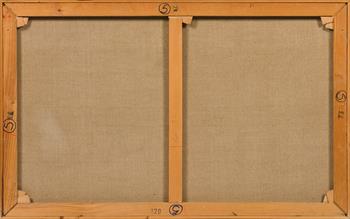0009
Werner Berg*
(Elberfeld 1904 - 1981 Rutarhof)
„Sonnenblumen“
1975
oil on canvas; framed
76 x 120.5 cm
monogrammed on the lower right: W.B.
Provenance
from the artist's family, private property, Carinthia
Literature
Wieland Schmied et al., Werner Berg. Gemälde, mit einem Werkverzeichnis von Harald Scheicher, Klagenfurt 1994, cat. no. 1035, ill. p. 317
Estimate: € 150.000 - 250.000
Result: € 203.550 (incl. fees)
Auction is closed.
“Here, the motif is completely permeated by the rhythm and vivid colour of the sunflowers that we grow in the field, ripe for harvest,” Werner Berg explained regarding this picture.
A sunflower field was an integral part of the crop rotation in the fields of his Rutar farm. After settling in Carinthia in 1931, he ran the mountain farm with his family over decades of what was at times hard, demanding work.
“Our old farm, which is situated on the south-western corner of a ground-down mountain plateau with a magnificent vista, is by no means a large estate and doesn’t allow us any great luxuries. Our agricultural activities are varied – with horses, cattle, pigs and all kinds of arable farming, and there’s no lack of fruit and vegetables. By economic standards everything may be quite ridiculous, but we have other standards. No romantic notions beguiled me when I once settled down on this mountain – I just wanted to be able to live and work independently,” Werner Berg wrote.
As with all his paintings of the farm and its immediate surroundings, he painted the sunflowers directly from life in the open air and subsequently refined the expression of the painting to a final clarity in the studio. This distinguishes these paintings from his many others, which were always created in the studio based on pencil sketches made when he was out and about.
Werner Berg often affirmed that he could only paint things that were part of his life – which, due to his direct involvement, made it possible for him to do “existential painting”, a pictorial parable of reality. This is particularly evident in his depictions of sunflowers, which he himself planted in spring and watched over in their soaring growth until the ripe heads were harvested. Powerfully proclaiming how successfully they have flourished up to the harvest, the four individual flowerheads stand out brilliantly against a darker sky – which, in the summer heat, seems to herald the threat of an approaching thunderstorm.
(Harald Scheicher)



